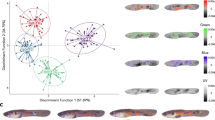Summary
In certainLebistes races the females (XX) are apt to show male characters and develop colour, though normally only males (XY) show colour patterns. By appropriate crossings of such races it proved possible to produce a fewXX males. Such males mated with normal females gave only females; through inbreeding it is possible to produce individuals again which are more or less altered in a male direction.
These experiments show that, although genes in theX-Y-chromosome pair normally are alone decisive as regards sex, it is possible through selection to produce types in which other chromosomes take over the sex determination. They show also that bothX-chromosomes and autosomes contain genes which have a share in the sex determination.
The remarkable fact that the closely relatedPlatypoecilus has homogametic males and heterogametic females is explained on the ground that the sex determination is of a quantitative nature, so that the heterogamety may change from being a male to being a female characteristic.
Aida’s so-called non-disjunctional males inAplocheilus (1930), which in like manner produce nearly all females, must be regarded, not as having arisen through non-disjunction, in which case they should containXXY, but as beingXX males.
Similar content being viewed by others
Literature
Aida, T. (1921). “On the inheritance of colour in a fresh-water fish,Aplocheilus latipes Temmick and Schlegel, with special reference to sex-linked inheritance.”Genetics,Vi, 554.
— (1930). “Further genetic studies ofAplocheilus latipes.”Ibid.,Xv, 1.
Blacher, L. J. (1926). “Fall von Hermaphroditismus bei Lebistes.”Transactions of the Lab. of Exp. Biology of the Zoopark of Moscow,I, 10.
Fraser, A. C. andGordon, M. (1928). “Crossing-over between theW andZ chromosomes of the KillifishPlatypoecilus.”Science,Xlvii, 470.
— (1929). “The genetics ofPlatypoecilus. II. The linkage of two sex-linked characters.”Genetics,Xiv, 160.
Geiser, S. W. (1924). “Sex-ratios and spermatogenesis in the Top-minnow,Gambusia Holbrooki Grd.”Biol. Bull. Xlvii, 175.
Gordon, M. (1927). “The genetics of a viviparous Top-minnowPlatypoecilus; the inheritance of two kinds of melanophores.”Genetics,Xii, 253.
Winge, Ö. (1922a). “A peculiar mode of inheritance and its cytological explanation.”Journ. Gen. Xii, 137.
— (1922b). “One-sided masculine and sex-linked inheritance inLebistes reticulatus.”Ibid. Xii, 145.
— (1923). “Crossing-over between theX- and theY-chromosomes inLebistes.”Ibid. Xiii, 201.
— (1927). “The location of eighteen genes inLebistes reticulatus.”Ibid. Xviii, 1.
Author information
Authors and Affiliations
Rights and permissions
About this article
Cite this article
Winge, Ö. On the occurrence ofXX males inLebistes, with some remarks on aida’s so-called “Non-disjunctional” males inAplocheilus . Journ. of Gen. 23, 69–76 (1930). https://doi.org/10.1007/BF03052594
Issue Date:
DOI: https://doi.org/10.1007/BF03052594




